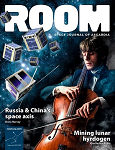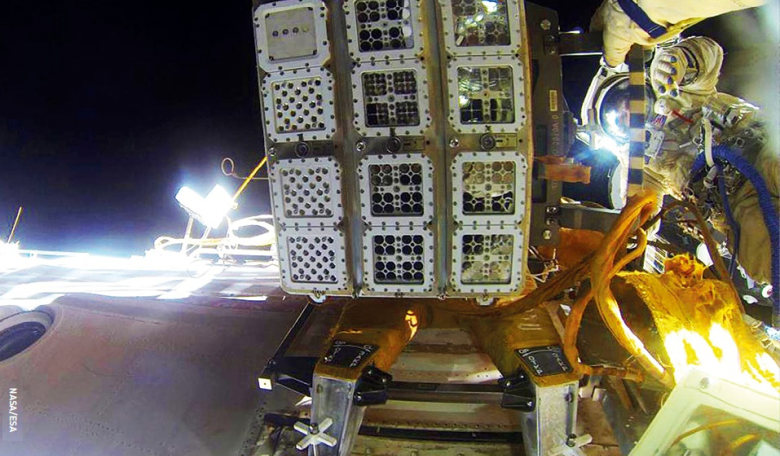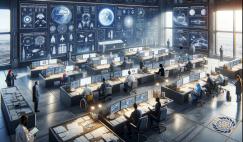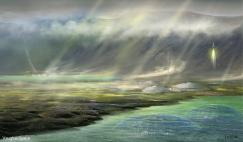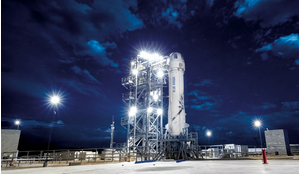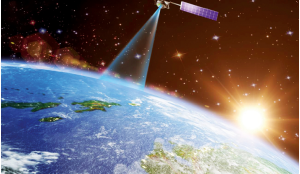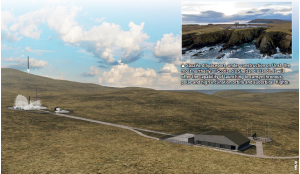The survival of microorganisms, and lifeforms in general, is one of the most important studies in space science, as it impacts not only crew survival on long-term space missions, but also the implications of contamination – from space to Earth or from Earth to space. Here, the authors describe a number of space-based experiments in the field.
One of the basic goals of space exploration is to study the evolutionary development of celestial bodies – planets, moons, comets, etc - to answer a number of important natural-science questions: what are the laws of formation and development of planets; how life emerged in the Universe and whether it exists beyond Earth; and whether there are preconditions for its genesis and development on other celestial bodies.
Paradoxically, the very development of astronautics may jeopardise this expensive research programme - because of potentially irreversible changes in the natural evolutionary development of celestial bodies - unless we act to prevent contamination of space by terrestrial lifeforms.
A much more serious danger is posed by the possibility of contamination of Earth by extraterrestrial pathogens or pathogenic microorganisms brought in by returning spacecraft from another planet or from outer space. In this context, it is extremely important to understand whether terrestrial microorganisms, which inevitably contaminate space equipment, are able to remain viable in outer space for long periods of time and what changes occur to them under these conditions.
Obtaining such data is not only of natural scientific interest, but also of invaluable practical importance for the development of a planetary defence concept based on the need to prevent the transfer of lifeforms, since it includes development of the strictest biological control and assessment of the potential pathogenicity of extraterrestrial substrates delivered to Earth by our own spacecraft.
Planetary protection
A much more serious danger is posed by the possibility of contamination of Earth by extraterrestrial pathogens or pathogenic microorganisms brought in by returning spacecraft
With this in mind, the most important area of research is ensuring planetary quarantine or, to word this concept more broadly, planetary protection. The presence of stable lifeforms may cause unauthorised anthropogenic spread of terrestrial organisms to other celestial bodies and, vice versa, infection of Earth by alien forms.
Space research on dormant forms of organisms belonging to various taxonomic groups is currently being performed within the framework of the Russian scientific programme. For example, within the framework of the BIORISK project (a Russian experiment), experiments with Expose-R (an ESA experiment involving Russia) are already being performed on the outer shell of the International Space Station (ISS).
However, the data from these experiments will not allow us to fully assess biological risks both in terms of addressing planetary protection issues and in terms of preparing medical and biological support for human interplanetary missions. This is because conditions in Earth orbit differ significantly from those in which the crews and accompanying organisms will have to live and work – not least as far as the level and spectra of radiation exposure and magnetic characteristics are concerned. For this reason, we need to study the response of biological objects across a wide taxonomic spectrum.
Life beyond Earth
Another important direction of research is the search for life beyond Earth, the search for an answer to the fundamental question about the uniqueness or typicality of the phenomenon of biological lifeforms in the Universe. In the foreseeable future, the search for life beyond Earth will be conducted on celestial bodies with conditions that are borderline for the existence of protein life and also allow for long-term viability in a state of deep dormancy. To detect the presence of life in such ecosystems, fundamentally different search technologies based on the properties of biological dormancy may be required.
It should be noted that not only microorganisms, but also organisms at higher development levels in the evolutionary chain, can demonstrate some form of dormancy, which ensures their survival in conditions incompatible with active life. It is no exaggeration to say that practically all living beings have the ability to periodically slow down their vital activity.
Apparently, special internal factors (e.g. biological clocks) are involved in the regulation of dormancy mechanisms, which allows us to raise the question of controlling these mechanisms both within individual organisms and at the level of ecosystems. The promising possibilities of signal control of adaptation processes in organisms belonging to different taxonomic groups in the phylogenetic lines, from bacteria to mammals and higher plants, are of considerable interest for exobiology. This interest defines several directions in studying the response of living systems to the space environment with experiments outside spacecraft.
The presence of stable lifeforms may cause unauthorised anthropogenic spread of terrestrial organisms to other celestial bodies and, vice versa, infection of Earth by alien forms
The most effective element of the astrobiological search algorithm would be the possibility of awakening dormant forms by adequate signals. The data obtained in the last decades in the field of research of natural habitats testify to the long-term survival of organisms in a state of deep dormancy under the most extreme conditions.
The Biorisk project provides a unique opportunity to assess the presence of biological matter in soil samples when exposed in near-Earth orbit. Thus the project will address a range of urgent exobiological problems concerning both the determination of the possibility of preserving the viability of various organisms during a long interplanetary flight and the search for life on other planets.
The Biorisk experiment
The Russian State Research Centre, Institute of Biomedical Problems of the Russian Academy of Sciences, has developed software and equipment for the Biorisk space experiment, which provides the possibility of long-term exposure of various microorganisms in three containers on the outer shell of the International Space Station (Figure 1).
The first stage of this work was to determine the possibility of preserving the viability of test cultures of microorganisms during long-term (comparable to the Earth-Mars-Earth mission) exposure in outer space, as well as to assess the impact of space factors on biological objects in relation to the planetary quarantine problem.
It established, for the first time, the process of long-term exposure of microorganisms and ‘artificial substrates’ in outer space corresponding to the interplanetary flight timeframe (18 months), indicating the possibility of preserving the viability of spore forms of bacteria and microscopic fungi. It was found that the majority of surviving strains have a protective-adaptive mechanism that kicks in, such that samples show increasing resistance to antimicrobial drugs after their stay in the extreme conditions of open space.
As a result of comparative electron-microscopic studies of postflight strains of bacteria and fungi, a number of features in cell ultrastructure were revealed, which to some extent explained the observed quantitative and qualitative changes at the population and functional levels. The most significant changes in spore viability were revealed in spore-forming bacilli (B.subtilis species) after exposure on the ISS outer shell, which coincided with the results of electron-microscope studies that revealed disturbances in the function of division and cell wall synthesis in these bacteria. They showed non-standard cell division, in particular, the appearance of a multiplicity of septa, which is an indirect indicator of the fact that, after exposure to outer space, there is a functioning disorder in a group of genes responsible for the processes of cell division.
Currently, the second stage of the Biorisk experiment using a wider range of biological objects is underway, in which dormant forms of animals (dry embryos of lower crustaceans, dry fish roe, dry larvae of chironomids) and seeds of higher plants are exposed to outer space. According to the results obtained after delivery of the first two containers to Earth, it was shown for the first time that not only spores of microorganisms, but also dormant forms of other organisms at higher levels of development (seeds of higher plants, mosquito larvae, eggs of lower crustaceans) retain their viability during a long stay (18 months) in the extreme conditions of outer space.
In the foreseeable future, the search for life beyond Earth will be conducted on celestial bodies with conditions that are borderline for the existence of protein life
In future experiments, it will be necessary to have sensors as part of the equipment to assess possible temperature fluctuations where the containers are mounted; this will allow us to assess the impact of this factor on organism viability and to conduct the most accurate selection of them for further experiments. It is also necessary to provide a heat shield for the containers to prevent overheating of the cups containing the biological objects. Finally, it is very important to evaluate the influence of UV radiation on biological objects and the structural design of the current equipment does not allow this to be done. Stage 3 of the Biorisk experiment will be carried out using the same equipment, using similar biological objects (microorganisms, plant seeds, larvae and eggs of insects, crustaceans), but the range of biological samples will be extended to include non-pathogenic bacteria and fungi representatives.
In addition to the purely scientific objectives of the Biorisk experiment third stage, the objectives related to ensuring the Earth’s quarantine will be addressed. According to the COSPAR classification of celestial bodies of the solar system and types of missions, the delivery of soil from Phobos to Earth belongs to category V, which provides for mandatory quarantine measures and microbiological studies of the soil delivered. In addition, together with the soil, biological objects (dormant stages of bacteria, fungi, animals and plants) are returned to Earth.
Analysis of the results of exposure of biological objects in the Biorisk experiment will allow a more complete assessment of the scope of necessary observational measures, because it will obtain new data on potential manifestations (limits) of phenotypic adjustment and genotypic changes in various biological objects. It also provides a comparative analysis of the effect on them of space conditions in Earth orbit and on the route of interplanetary missions, which differ significantly in the level and spectra of radiation exposure, magnetic characteristics, etc.
Expose-R experiment
The Expose-R experiment was launched on 10 March 2009 and placed on the outside of the ISS. The main difference between the Expose-R experiment and the Biorisk experiment is the possibility of assessing the effect of short-wave ultraviolet radiation, which does not reach the Earth’s surface. This experiment involves scientists representing ESA as well as researchers from the Russian State Research Center - IBMP RAS.
The equipment for ESA’s Expose-R was designed and manufactured by Kayser-Threde (Germany) with the help of IBMP RAS scientists. It consists of a metal case containing three cassettes, each of which has four cells that hold assemblies with biological samples (Figure 2). Some of the samples in the assemblies are sealed, some are not. Assemblies with biological samples are placed in the cells of cassettes and sealed with special magnesium glasses. Tightness is ensured by a rubber gasket between the metal body of the cassette and the glass and all cells in each cassette are connected with each other by an air channel designed for air removal.
Not only microorganisms, but also organisms at higher development levels in the evolutionary chain, can demonstrate some form of dormancy
During one year of exposure on the external surface of the ISS RS, biological samples will be affected by solar radiation in space vacuum conditions. The results of studies of preservation of bacteria and microscopic fungi viability in outer space and assessment of changes in their biological properties (antibiotic resistance) under extreme outer space environment allow us to draw the following conclusions:
1. In the process of long-term exposure in the framework of the Expose-R2 experiment the possibility of long-term preservation of the viability of spore forms of microorganisms was established.
2. The destructive effect of hard space ultraviolet radiation (with a wavelength above 200 nm) on the viability of spores of various microorganisms has been established. Bacterial spores exposed to outer space that survived in the absence of ultraviolet radiation died under its impact, but an insignificant number of spores of microscopic fungi partially retained their viability under such conditions.
3. Most ‘flight’ bacterial strains had increased antibiotic resistance compared to the control samples.
4. Mould forms of fungi showed more pronounced changes in antibiotic resistance after the flight, apparently due to changes in cell membrane permeability, which were not unidirectional.
Assessing the research results obtained in both experiments - Expose-R and Expose-R2 - where microorganisms were exposed to UV for 22 and 15.5 months, respectively, it can be concluded that high-energy space UV radiation is one of the most inhibitory factors affecting living matter in outer space. From the data obtained in the Expose-R experiment it follows that only single colony-forming units of aspergillus remained viable in the upper layer under the impact of space UV radiation. In turn, in the experiment Expose-R2, where filters retaining UV radiation above 200 nanometres were installed on top of the cells with samples, not only the above-mentioned fungi survived, but also fungi of all other tested species (although in smaller numbers).
However, spore-forming bacilli were killed in the upper layer of the assemblies in both the first and the second experiments (in which data on their survival in thousands of a percent cannot be considered statistically reliable given the number of samples). In the middle and lower layers of the assemblies, all utilised microorganisms and micromycetes were preserved, and the further away from the top layer, the bigger their number was. Despite the fact that these values are very small, it is important to note that the shielding effect (presence of filters) increases the chances of microorganisms to remain viable in an open space environment.
Since the conditions of spaceflight include a large number of various physical and chemical factors, some of which cannot be fully reproduced in laboratory conditions on Earth, it becomes very difficult to identify the specific ways and mechanisms of changes in physiological, biochemical processes, even in a bacterial cell. However, the results obtained relate to such an urgent area of space research - the coexistence of microorganisms and humans in a confined environment (especially with regard to long-term human missions exploring other space bodies) - and deserve close attention in further research.
Experiments on satellites
The Biorisk project provides a unique opportunity to assess the presence of biological matter in soil samples when exposed in near-Earth orbit
The Soviet-French Cytos experiment was aimed at studying the properties of microorganisms under exposure conditions in the Bion unmanned spacecraft, mainly changes in sensitivity to antibiotics and the frequency of the spread of drug resistant genes. Based on the studies, it was demonstrated that sensitivity to antibiotics under spaceflight environment changes insignificantly.
Numerous studies performed in vitro as a result of exposure of microorganisms cultures (Staphylococcus aureus and Escherichia coli) in the space mission environment of the Bion series biosatellites show only a slight increase in sensitivity to beta-lactams, aminoglycosides, colistin and chloramphenicol (Tables 1 and 2). However, this minor change was sufficient to move the cultures under study from the category of sensitive to moderately sensitive and moderately sensitive to the resistant category, which is very important for predicting the success of antibiotic therapy when prescribed.
As for the frequency of genetic factors, it did not change significantly. Subsequent studies within the framework of the Plasmid experiment on the ISS RS made it possible to come to more detailed conclusions, using hardware Recomb-K (produced by BioTechSys Co) (Figure 3). Thus, it was noted that the frequency of transfer of extrachromosomal heredity factors of Gram-positive rods determining resistance to antibiotics increased by an average of 10 times. The above specifics did not involve the Gram-negative flora (Table 3).
At the same time, the segregation stability of plasmid cointegrates formed as a result of in vitro studies performed in space flight is much higher in a space mission environment (Table 4). That is, gene co-integrates determining multidrug resistance formed under space experiment conditions on the ISS are more robust as compared to those obtained in the control settings.
This circumstance is a risk factor, since there are reasons to assume a rather intensive formation of strains with signs of hospitalism in the prolonged space flight environment. Meanwhile, the frequency of plasmid transfer by transduction, the most common form for staphylococci so common in the habitat of human spacecraft, remained unchanged and at a low level (Table 5).
Meteorite experiment
Transportation of microorganisms in space is an important matter from both theoretical (origin of life on Earth) and practical (planetary protection) points of view. One of the most feasible mechanisms for interplanetary transportation is the natural transfer of organisms in rocks, known as lithopanspermia. It is presumed to include three main steps: ejection of rock from the planet’s surface, transfer into space and entry into the atmosphere.
One of the key conditions of the lithopanspermia hypothesis is that microorganisms inside meteorites are able to survive the ultrafast entry from space through the Earth’s atmosphere. So far, all experimental evidence for this possibility is based on tests using rockets that do not reach the natural flight speeds of meteorites.
The survival of spore-forming thermophilic anaerobic Thermoanaerobacter siderophilus bacteria, placed in 1.4 cm thick basalt disks fixed on the outer side of the space capsule, was studied in the Meteorite experiment on the Photon-M4 satellite, which performed a 45-day orbital flight and returned a spacecraft landing module to Earth. The temperature during the atmospheric transition was high enough to melt the basalt surface. Thermoanaerobacter siderophilus survived the penetration and viable cells were recovered from four out of 24 slots loaded with this microorganism (Figure 4).
The identity of the strain was confirmed by a 16S rRNA gene sequence and physiological tests. This is the first report of a lifeform surviving inside an ‘artificial meteorite’ after deorbiting through the Earth’s atmosphere at a velocity close to that of a natural meteorite. The entry speed of the Photon capsule (7.7 km/sec) was somewhat lower than that of average size natural meteorites (10-20 km/sec), but was still high enough to melt the basalt, indicating a surface temperature higher than 1100oC.
Paleomagnetic studies of the Martian meteorite ALH84001 have shown that just 3 mm below the surface of its fusion crust, the interior never heated to more than about 40oC during the entire history of its ejection from Mars, interplanetary transit to Earth, and passage through the atmosphere. However, many meteorites break up into fragments upon re-entry, so the presumed microbial population originally living deep in the rock are exposed to high temperatures in the newly formed near-surface areas. Thus, if the meteorite were to split, heat-resistant microorganisms or spores would have a better chance of surviving.
In the framework of the Expose-R2 experiment the possibility of long-term preservation of the viability of spore forms of microorganisms was established
Hypothetically, a thickness of a few centimetres seems enough to fully protect the escaping objects from extensive heating. However, so far all experimental attempts to demonstrate the survival of mesophilic microorganisms and spores inside artificial meteorites at a depth of 1-2 cm, entering the atmosphere at a velocity of more than 7.5 km/sec, have failed. It is likely that microorganisms must be protected by rock at least 5 cm thick to save from the intense heat. Our data suggest that a 1.4 cm thick basalt layer protects a spore-forming thermophilic microorganism from the heat generated by a meteorite entering the atmosphere at a velocity of 7.7 km/sec.
In addition to the results of the Bion M 1 and Photon M 4 spacecraft missions described above, experiments were performed inside the spacecraft using the Biocont equipment. (Figure 5). Thus, based on the example of Streptomycetes it was noted that environmental factors can significantly change morphogenesis (i.e. the stages of differentiation of microorganisms), which is manifested in atypical colonies emerging with high frequency, changes in the level of sporulation. It was demonstrated that the reason for this is the reversible transposition or change in the genetic structure of chromosomes. It was found that the frequency of occurrence of non-sporulating colonies in flight samples is 35-40 percent higher than in control samples. Furthermore, flight patterns produce atypical slime colonies that are not found in control samples.
In the study of plasmid DNA transfer among unrelated strains, namely plasmid transfer from Escherichia coli to streptomycetes, it was demonstrated that the efficiency of plasmid transfer was 50-60 percent higher in flight samples than in control ones. The process of chromosomal DNA transfer during crossing of Streptomycetes strains was investigated. It was demonstrated that chromosome transfer from the donor strain to the recipient strain is carried out completely and more efficiently than in control samples.
The reason for this may be the longer-term contact between cells in zero gravity, during which the donor chromosome is transferred to the recipient cell. This leads to increased genetic diversity of recombinant offspring under flight conditions. It has been concluded that the exchange of genetic material among different strains of microorganisms increases under flight conditions. This may lead to the emergence of microorganisms with new combinations of genes and new physiological and biochemical properties. Increased phagoproduction in lysogenic Streptomycetes has been detected, up to and including the point of culture lysis.
Experiments using Exobiofrost
The Exobiofrost equipment (Figure 6) makes it possible to expose bio-objects to the open space environment in special containers, which are closed with a lid during re-entry to prevent overheating during passage through dense layers of the atmosphere. The results of the Exobiofrost experiment on the BION-M1 biosatellite demonstrated that the impact of spaceflight factors (ionising radiation, G-forces, and temperature fluctuations) did not lead to complete sterilisation of permafrost samples.
A significant part of the bacterial community remained viable after the flight experiment. Post-flight analysis and comparison with control samples showed that modern tundra colpods are more resistant to space conditions than fossil representatives, and Colpoda steinii strains are more resistant than infusoria of the Exocolpoda augustini species. Acanthamoeba cysts (Acanthamoeba sp.) showed the greatest resistance in the experiment, and can be considered as model organisms for further experiments, both in outer space and on Earth.
Furthermore, after being in orbit, the spores of 13 of the 20 fungi studied in the Exomicology experiment remained viable. In 2 of the 20 fungal species studied, Acremonium potronii and Aspergillus versicolor, almost no spores lost viability. On average, 10 percent of five species of fungi, A.niger, Chaetomium globosum, Penicillium chrysogenum, P.verrucosum and Purpureocillium lilacinum spores germinated. Thus, both micromycetes are able to remain viable in open space environment and further study of this problem is promising.
Our results show that we now have a lot of information for further reflection, and we are very eager to continue the research we have started. Perhaps in the future we will be the first to get closer to solving the mystery of the emergence of life on Earth.
About the authors
Oleg I Orlov, Dr.Sci. (Med.), M.S., MBA is a Full Member of the Russian Academy of Sciences (RAS) and of the International Academy of Astronautics (IAA), and is a Director of the Institute of Biomedical Problems of the Russian Academy of Sciences (IBMP RAS), Moscow, Russia.
Viacheslav K. Ilyin is a Correspondent Member of the Russian Academy of Sciences (RAS). He is a Dead of Department of Sanitary-Hygiene Safety of Humans in Artificial Environment and Head of Laboratory of Human Microbial Ecology of the Institute of Biomedical Problems of the Russian Academy of Sciences (IBMP RAS), Moscow, Russia.
Elena A. Deshevaya is with the Institute of Biomedical Problems of the Russian Academy of Sciences. She is a leading researcher in the field of mycology in the Laboratory of Environmental Microbiology and Antimicrobial Protection.
Svetlana V. Poddubko is with the Institute of Biomedical Problems of the Russian Academy of Sciences and is a leading researcher in the Laboratory of Environmental Microbiology and Antimicrobial Protection.
Yuliya A. Morozova is with the Institute of Biomedical Problems of the Russian Academy of Sciences and is a researcher in the of Laboratory of Human Microbial Ecology.
References
1. Levinskikh M. A., Novikova N.D., Podolsky I.G., Sychev V.N., Gostimsky S.A., Alekseev V.R., Bingham G.E. Main results of experiments on studying higher plants and the dormant forms of organisms on board the Russian segment of the International Space Station // Cosmonautics and rocket science. 2007. Vol. 49. Issue 4. pp. 54-63.
2. Alekseev V.R., Sychev V.N., Novikova N.D. Studying the phenomenon of dormancy: Why It Is Important for Space Exploration / Diapause in aquatic invertebrates: theory and human use. Eds V. Alekseev, B. DeStasio & J. Gilbert.@ISBN 978-14020-5679-6, Springer Verlag Publishers. 2007. pp.. 207–214.
3. Gusev O., Nakahara Y., Sychev V., Levinskikh M., Novikova N., Alexeev V., Kikawada T., Okuda T. An anhydrobiotic insect Polypedilum vanderplanki as a tool for Astrobiology // Space Utilization Research. 2008. No. 24. pp. 306–309.
4. Novikova N., Polikarpov N., Deshevaya E., Levinskikh M., Alekseev V., Okuda T., Sugimoto M., Gusev O., Sychev V., Grigoriev A. Long-term exposure of dormant forms of various organisms to outer space: an overview // Acta Astronautica. 2011. No 68. pp. 1574–1580.
5. Novikova N., Polikarpov N., Sychev V., Deshevaya E., Levinskikh M. Main results and prospects of the Biorisk space experiment // International Space Station Russian Segment. Voronezh. 2013. Vol. 2. pp. 273-307.
6. Novikova N., Deshevaya E., Levinskikh M., Polikarpov N., Poddubko S., Gusev O., Sychev V. Study of the effect of the outer space environment on the dormant forms of microorganisms, fungi and plants in the «Expose - R» experiment // International Journal of Astrobiology. 2015. 14 (1). pp. 137–142.
7. Orlov O.I., Novikova N.D., Polikarpov N.O., Levinskikh M.A., Deshevaya E.A., Sugimoto M., Alekseev V.R., Okuda T., Gusev O.A., Sychev V.N.. Planetary protection challenges in space exploration missions and ways of their resolution with account of the results of Russian exobiology experiments // REACH – Reviews in Human Space Exploration. 2017. pp. 25–33.
8. Voeikova T.A., Emelyanova L.K., Starkova L.V., Ilyin V.K., et al. Specificities of plasmid and chromosomal DNA exchange in microorganisms under the conditions of spaceflight. «Journal of Gravitational Physiology» 2010,17,1, 14-18.
9. T.L. Goins, K.S. Lim, A.M. Smith, S.C. Broadaway, T. A. Voeikova, V.K. Ilyin, B.H. Pyle. Molecular analysis of spaceflight effects on several species of microorganisms. Journal of Gravitational Physiology, 2008, vol.16, p.127-130.
10. P.DeBoever, Ilyin V.K., D.Hanus, G.Van der Auvera, et al. Conjugation-mediated plasmid exchange between bacteria grown under space conditions Z-Tec Publishing, Bremen Microgravity Sci Tecnol. XIX-5/6 2007, 138-144.
11. A.Slobodkin, S.Gavrilov, V.Ionov, V.Ilyin Spore-forming thermophylic bacterium within artificial meteorite survives entry into the earth atmosphere on Foton M4 satellite landing module. Plos One 10 (7) 2015 1-13.
12. V.K.Ilyin, O.I.Orlov, Yu.A.Morozova, M.A.Skedina, S.K.Vladimirov, E.V.Plotnikov, A.A.Artamonov. Prognostic model for bacterial drug resistance genes horizontal spread in space-crews Acta Astronautica.Volume 190, January 2022, Pages 388-394.


